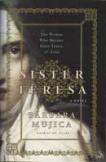No Plaster Here
Doña Teresa de Ahumada y Cepeda, who became simply Teresa de Jesús following her midlife conversion, had a personality so large and intriguing that it is no surprise that a novelist has chosen this Spanish Carmelite as a character around whom to weave a fictionalized story. Yet historical novels are a veritable minefield. The historian Herbert Butterfield described the task of uniting history and fiction as akin to putting “a poem…to music.” The history must be authentic and the fiction a genuine exploration of human experience. As the historian Helen Cam demanded, “the historical novel should be both good literature and good history.” In 1961 Cam published a pamphlet, Historical Novels, that rates how well a long list of such books lives up to her demanding standards.
Barbara Mujica is extraordinarily qualified to bring together the ethos of 16th-century Spain with a woman from that era whom no one can ignore, St. Teresa of ávila, foundress, mystic, saint and first woman doctor of the church. Mujica is a widely published and highly regarded scholar from the Spanish and Portuguese Department at Georgetown University, and a prize-winning author of short stories and novels. Mujica’s Frida: a Novel explored another woman with an outsized personality, the Mexican artist Frida Kahlo, in a book that has been much acclaimed and translated into 14 languages.
Sister Teresa is a lively, vivid and fast-paced story that holds one’s attention as it follows Teresa as a vivacious young woman, whose ancestors were Jews who were converted to Catholicism, and then her entry and life in the large and unreformed monastery of the Incarnation outside the walls of ávila. Teresa’s midlife conversion signaled an initiation into a life of ever-deepening love of God and mystical encounters. The novel tells of Teresa’s role as a foundress of some 17 monasteries for women and ends with her death at age 67 at Alba de Tormes. This sequence of events is well known to readers of Teresa’s Book of Her Life, The Way of Perfection, the Book of Foundations and Teresa’s masterpiece, The Interior Castle. Teresa reveals much about herself not only in her Vida but in everything she wrote. Mujica’s spirited imagination takes the reader behind the scenes of those events.
Mujica displays an impressive knowledge of life in 16th-century Spain; one leaves this book knowing much more about domestic conditions and everyday life than most people could acquire by many years of research. On the other hand, this book does not explore deeply the mystical elements of Teresa, her inner growth in prayer and love. For that story I recommend going directly to Teresa’s own writings, where the emphasis is on God’s loving activity in a heart that was pierced by Love itself. Teresa shared her spiritual experience as a way of giving spiritual guidance to her daughters. In doing so she has enriched the horizons of those who seek a deeper and more spiritual way of living. Mujica, on the other hand, emphasizes a kind of anti-hagiography, in which she puts Teresa’s humanity front and center. Some devotees of Teresa will no doubt find the earthy and sometimes crude language in this novel off-putting. Teresa’s passing mention of an affectionate friendship with a male cousin is here imagined as a more passionate relationship than Teresa described.
The conceit of this novel is the modern discovery of a journal kept by a nun who became a confidante of Teresa of Jesus. The journal was composed by a seamstress’ daughter, Pancracia, who as a Carmelite becomes Sister Angelica of the Sacred Heart. Angelica (the novel’s narrator) is a worldly, even flighty and skeptical nun, whose ongoing affair with a priest makes her a bold and graphic foil to Teresa. La Madre, as Teresa’s daughters knew her, is seen through the eyes of Angelica, who sometimes becomes the novel’s central protagonist.
Mujica rightly shows Jerome Gracian, not John of the Cross, to be Teresa’s favorite male friend. The latter was indeed Teresa’s indispensable collaborator and valued confessor but not her intimate friend. In this novel John has a very minor role. Mujica makes much of Teresa’s Jewish background, which in real life may not have figured much, if at all, in Teresa’s self-awareness. The Spanish Inquisition, a mixture of secular and religious authorities, is an unsettling presence in the novel, more so than Teresa reveals in her writings.
Why read this novel when so many of Teresa’s texts are available in excellent modern translations? That question pertains to all well-written historical novels. But Sister Teresa offers a vivid contact with everyday life in Spain’s Golden Age. If it motivates one to learn more about that era and that place, reading this enjoyable story is time well spent. If it sends one to study Teresa’s own writings, which are Christian and world classics, all the better. This novel by Mujica, a natural story teller, may give one a taste for the stories of God that Teresa told with such gusto. For some it will be enough that this novel is a lively read about religiously inclined people of a bygone era.
This article also appeared in print, under the headline “No Plaster Here,” in the November 17, 2008, issue.








